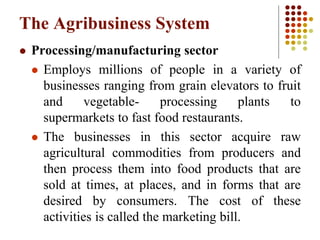Introduction to agribusiness marketing
- 1. CBU 5205 Agribusiness Marketing Topic 1 Introduction Daisy Odunze
- 2. Introduction ’ü¼ Agribusiness includes not only those that farm the land, but also: ’ü¼ the people and firms that provide the inputs (e.g. seeds, chemicals, and credit); ’ü¼ process the output (e.g. milk, grain, and meat); manufacture the food products (e.g. ice cream, bread, and breakfast cereals); and ’ü¼ transport and sell the food products (e.g. restaurants and supermarkets) to consumers.
- 3. Introduction ’ü¼ Agriculture has undergone a rapid transformation as new industries evolved and traditional farming operations grew larger and more specialized. The transformation did not happen overnight, but came slowly as a response to a variety of forces. ’ü¼ Evolution of Agribusiness
- 4. The Agribusiness System Agricultural input sector Production sector Processing- manufacturing sector To capture the full meaning of the term ŌĆ£agribusinessŌĆØ it is important to visualize these three sectors as interrelated. The success of each part depends heavily on the proper functioning of the other two.
- 5. The Agribusiness System ’ü¼ Input sector ’ü¼ This sector is a large part of agribusiness. ’ü¼ It provides producers with the feed, seed, credit, machinery, fuel, chemicals, they need to operate. ’ü¼ This sector provides 75% of the input used in production agriculture. ’ü¼ Improvements in the quality of purchased inputs have been a large source of efficiency gains for the entire system. ’ü¼ The trend towards the use of more purchased input will continue
- 6. The Agribusiness System ’ü¼ Production sector ’ü¼ The middle part of agribusiness is the production sector. ’ü¼ In the recent years, producers have specialized into one or a few crops or types of livestock in order to be able to increase the efficiency of their operations and become production experts. ’ü¼ The agricultural production sector has been the cause of much of the change in agribusiness. They, in turn, have been changed by development in other areas of agribusiness, particularly in technology.
- 7. The Agribusiness System ’ü¼ Processing/manufacturing sector ’ü¼ Employs millions of people in a variety of businesses ranging from grain elevators to fruit and vegetable- processing plants to supermarkets to fast food restaurants. ’ü¼ The businesses in this sector acquire raw agricultural commodities from producers and then process them into food products that are sold at times, at places, and in forms that are desired by consumers. The cost of these activities is called the marketing bill.
- 8. Definition of Agribusiness ’ü¼ John Davis and Ray Goldberg (1957), defined agribusiness as all operations involved in the manufacture and distribution of farm suppliers; processing, and distribution of the resulting commodities and items. ’ü¼ Ewell Roy (1980) defined agribusiness as the ŌĆ£coordinating science of supplying agricultural production inputs and subsequently producing, processing and distributing food and fibre.
- 9. Definition of Agribusiness ’ü¼ An inclusive definition of agribusiness was provided by the Australian Department of Agriculture, Fisheries and forestry. The ADAFF called the agribusiness sector a ŌĆ£chainŌĆØ of industries directly or indirectly involved in the production, transformation, or provision of food, fibre, chemical and pharmaceutical substrates.
- 10. Definition of Agribusiness ’ü¼ Agribusiness is the coordination of all activities that contribute to the production, processing, marketing, distribution, financing and development of agricultural commodities and resources. This includes food, fibre, wood products, natural resources, horticulture, and other plant and animal products and services.
- 11. Definition of Agribusiness ’ü¼ Scope of agribusiness.
- 12. Definition of Agribusiness Marketing ’ü¼ Agribusiness marketing can best be defined as series of services involved in moving a product from the point of production to the point of consumption. It is a series of inter-connected activities involving: planning production, growing and harvesting, grading, packing, transport, storage, agro-and food processing, distribution and sale.
- 13. Conflicting Needs of Producers and Consumers ’ü¼ Conflicting needs of producers and consumers that agrimarketing seeks to reconcile. ’ü¼ Producers try to consumers try to ’ü¼ Maximize profit Maximize the over the long term satisfaction they receive from the products they buy With their limited incomes ’ü¼ Sell large quantities Buy small quantities of fewer products of many products ’ü¼ Obtain the highest Obtain the lowest prices prices
- 14. Conflicting Needs of Producers and Consumers ’ü¼ Marketing plays a key role in the success of any economy by bridging the gap between the differing needs of producers and consumers. ’ü¼ Marketing helps producers to decide what products to produce and when to produce them. Marketing also helps consumers by letting them know what products are available at what price. ’ü¼ When done well, it leads to greater satisfaction for consumers and higher profits for producers.
- 15. Conflicting Needs of Producers and Consumers ’ü¼ Agribusiness is the largest industry in most developed nations, and marketing is its largest segment. More than 80 % of those involved in agribusiness are employed in marketing
- 16. Role of Marketing in the Agribusiness System ’ü¼ In any economic system there are always barriers between producers and consumers that prevent producers from efficiently meeting consumer needs. ’ü¼ These include separations of space, time, information and ownership. The role of marketing system is to overcome these separations by building a bridge between producers and consumers
- 17. Role of Marketing in the Agribusiness System ’ü¼ The most familiar marketing function. ’ü¼ Must occur in the marketing system if any product exchanges are going to occur. ’ü¼ Overcomes separations of ownership by exchanging legal title of the product for money between the buyer and seller.
- 18. Role of Marketing in the Agribusiness System ’ü¼ Physical functions: Storage: ’ü¼ Agricultural supply is seasonal while demand is continuous. This gives rise to the need for storage. ’ü¼ The storage function is one of balancing supply and demand. ’ü¼ It overcomes the separation of time by keeping the product in good condition between production and the final sale. ’ü¼ A farmer, merchant, co-operative, marketing board or retailer who stores a product provides a service. And should earn a profit from that service. ’ü¼ Both growers and consumers gain from a marketing system that can make produce available when it is needed.
- 19. Role of Marketing in the Agribusiness System ’ü¼ Physical functions: Transportation: ’ü¼ The transport function is chiefly one of making the product available where it is needed, without adding unreasonably to the overall cost of the produce. ’ü¼ It overcomes the separation of space by moving the product from where it is produced to where the consumer is willing to purchase it
- 20. Role of Marketing in the Agribusiness System ’ü¼ Physical functions: Processing: ’ü¼ This function is responsible for changing the form of a commodity to a form that has greater value to the consumer. ’ü¼ The form changing activity is one that adds value to the product. ’ü¼ Does not overcome any gap but it increases the utility of the product.
- 21. Role of Marketing in the Agribusiness System
- 22. Role of Marketing in the Agribusiness System ’ü¼ Facilitating functions: Standardisation: ’ü¼ Establishment and maintenance of uniform measurements of produce quality and/or quantity. ’ü¼ Simplifies buying and selling as well as reducing marketing costs by enabling buyers to specify precisely what they want and suppliers to communicate what they are able and willing to supply with respect to both quantity and quality of product. ’ü¼ Overcomes the information gap ’ü¼ Impossible to trade without this function
- 23. Role of Marketing in the Agribusiness System ’ü¼ Facilitating functions: Financing: ’ü¼ An inevitable lag between investing and sale and someone must finance the lag. ’ü¼ The question of where the funding of the investment is to come from, at all points between production and consumption, is one that marketing must address. ’ü¼ Overcomes time separation.
- 24. Role of Marketing in the Agribusiness System ’ü¼ Facilitating functions : Risk bearing: ’ü¼ Involves assuming the risk of loss between the time of purchase and sale. In both the production (physical risk)and marketing of produce the possibility of incurring losses is always present (marketing risk). ’ü¼ Overcomes the separation of time
- 25. Role of Marketing in the Agribusiness System ’ü¼ Facilitating functions : Market intelligence: ’ü¼ As far as is possible marketing decisions should be based on sound information. ’ü¼ The role of market intelligence is to reduce the level of risk in decision making. ’ü¼ It establishes what products are right for the market, which channels of distribution are most appropriate, how best to promote products and what prices are acceptable to the market. ’ü¼ Overcomes the gap of information
- 26. Utilities of Marketing ’ü¼ A useful way to think about the utility process is to think of them as adding value to the product. ’ü¼ Form utility: this means to process the product into a form desired or needed by the consumer. ’ü¼ Place utility: this means transporting the product to a location desired by the consumer. ’ü¼ Time utility: this means storing the product until the time it is needed by the consumer. ’ü¼ Possession utility: this allows consumers to gain ownership of the product legally.
- 27. Utilities of Marketing ’ü¼ Each of these utilities is added to the product by performing one or more of the nine marketing functions. ’ü¼ Form utility is created by processing. ’ü¼ Place utility is created through the transportation function. ’ü¼ Time utility comes from the storage function. ’ü¼ Possession utility is created by the buying and selling functions. ’ü¼ In this way the barriers of space, time, information, value and ownership are overcome for the producer and consumers.
- 28. The end ’ü¼ Energiser: ’ü¼ Consider one of the best-selling fast- food items, the cheeseburger. To get an idea of how agribusiness affects our daily lives, ’ü¼ imagine what is involved in assembling a cheeseburger with all the trimmings. ’ü¼ List at least 10 businesses or services that are needed to get a cheeseburger ready for consumption.




























